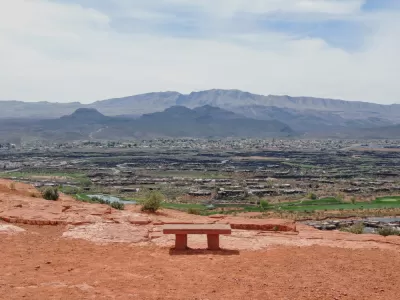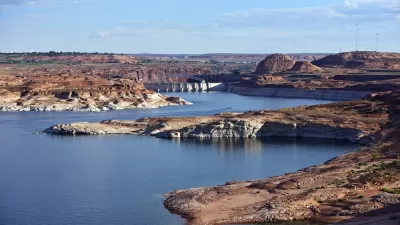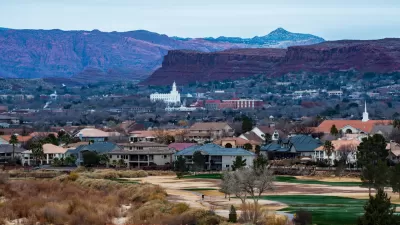Cheap water flows freely to the golf courses of St. George, Utah, but all the new residents mean it’s going to have to increase supply or reduce demand—or both.

St. George, Utah was recently named the fastest growing metropolitan area in the country; it is also in one of the driest climates in the country, which means that providing enough water will be an enormous challenge, writes Jake Bullinger at CityLab.
As is the case with other growing desert burgs, St. George grapples with water-supply issues. But the challenge here is unique. Remarkably cheap rates mean that residents of an area with only eight inches of annual rainfall are using tremendous amounts of water. An average St. George resident uses more than twice as much water as the average citizen of Los Angeles.
As in many dry cities, one of the most significant uses of water is outdoor irrigation (St. George has traditionally been a retirement community, with lots of golf courses). In some places, watering all that grass would be an expensive proposition, but in most of Utah, untreated "secondary water" is nearly free.
The question for St. George now is whether to push forward with a major infrastructure project that would provide a new source of water, or to focus on reducing demand through conservation.
The project—a pipeline that would bring more water from Lake Powell—is hugely expensive, but even if it weren’t, there’s a question of how much more water can be wrung from the Colorado River, which is shrinking in the short term due to drought and in the long term due to climate change.
“In this blossoming desert city,: Bullinger writes, “leaders have a choice: Do they let the roses go brown, or pay exorbitantly to keep them?”
FULL STORY: America's Fastest-Growing Urban Area Has a Water Problem

Alabama: Trump Terminates Settlements for Black Communities Harmed By Raw Sewage
Trump deemed the landmark civil rights agreement “illegal DEI and environmental justice policy.”

Planetizen Federal Action Tracker
A weekly monitor of how Trump’s orders and actions are impacting planners and planning in America.

The 120 Year Old Tiny Home Villages That Sheltered San Francisco’s Earthquake Refugees
More than a century ago, San Francisco mobilized to house thousands of residents displaced by the 1906 earthquake. Could their strategy offer a model for the present?

Ken Jennings Launches Transit Web Series
The Jeopardy champ wants you to ride public transit.

BLM To Rescind Public Lands Rule
The change will downgrade conservation, once again putting federal land at risk for mining and other extractive uses.

Indy Neighborhood Group Builds Temporary Multi-Use Path
Community members, aided in part by funding from the city, repurposed a vehicle lane to create a protected bike and pedestrian path for the summer season.
Urban Design for Planners 1: Software Tools
This six-course series explores essential urban design concepts using open source software and equips planners with the tools they need to participate fully in the urban design process.
Planning for Universal Design
Learn the tools for implementing Universal Design in planning regulations.
Clanton & Associates, Inc.
Jessamine County Fiscal Court
Institute for Housing and Urban Development Studies (IHS)
City of Grandview
Harvard GSD Executive Education
Toledo-Lucas County Plan Commissions
Salt Lake City
NYU Wagner Graduate School of Public Service





























